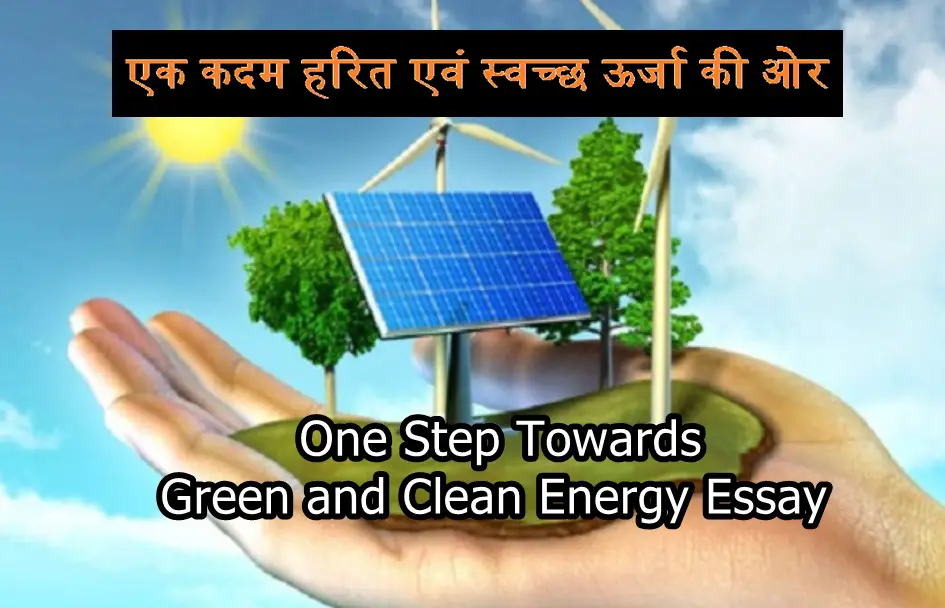एक कदम हरित एवं स्वच्छ ऊर्जा की ओर Essay Hindi PDF
The Ministry of Petroleum and Natural Gas has organized a competition all over India. It also has essay competition. And the essay is the subject of the competition. “One step towards green and clean energy” ( एक कदम हरित एवं स्वच्छ ऊर्जा की ओर – Ek Kadam harit avam Swachchha urja ki or Nibandh )Today we are presenting the essay for this in Hindi and English and Gujarati.
‘Saksham’ aims to convince consumers to move towards cleaner fuels and bring behavioral changes to use fossil fuels wisely.
With a view to creating awareness among consumers of fossil fuels, the Petroleum Conservation Research Association (PCRA), Ministry of Petroleum and Natural Gas launched a month-long campaign outlining the adverse health and environmental impacts of rising carbon footprint. Secretary of the Ministry of Petroleum and Natural Gas and Chairman of PCRA Mr. Tarun Kapoor started the campaign here today. ‘Saksham’ aims to convince consumers to move towards cleaner fuels and bring behavioral changes to use fossil fuels wisely.

एक कदम हरित एवं स्वच्छ ऊर्जा की ओर निबंध In Hindi
स्वच्छ, नवीकरणीय ऊर्जा का उपयोग करना पर्यावरण पर आपके प्रभाव को कम करने के लिए सबसे महत्वपूर्ण कार्यों में से एक है। बिजली का उत्पादन हमारे, ग्रीनहाउस गैसों का स्रोत है, जो हमारी ड्राइविंग और उड़ान से अधिक है, और स्वच्छ ऊर्जा हमारे वायु और पानी में हानिकारक स्मॉग, विषाक्त बिल्डअप और कोयला खनन और गैस निष्कर्षण के कारण होने वाले प्रभावों को भी कम करती है। लेकिन हमारे जीवाश्म-ईंधन बुनियादी ढांचे की जगह लेने में समय लगेगा और नवीकरणीय ऊर्जा उत्पादन और उपभोक्ताओं और व्यवसायों से स्वच्छ ऊर्जा की मांग के लिए सभी को साथ मिलकर काम करने की जरुरत है.
ऊर्जा अर्थव्यवस्था की रीढ है, यह औद्योगिक प्रक्रियाओं को मजबूती प्रदान करती है और लोगों का जीवन स्तर सुधारने में अहम भूमिका निभाती है। भारत की प्रति व्यक्ति ऊर्जा खपत बहुत कम, वैश्विक औसत का लगभग 30% है। ऐसे में, भारत जब अपनी अर्थव्यवस्था को सुदृढ़ बनाने और लोगों को आजीविका के बेहतर अवसर प्रदान करने के लिये कदम उठायेगा तब ऊर्जा की खपत भी बढ़ेगी।
हालांकि, यह एक चुनौती है। जीवाश्म ईंधन के मामले में भारत की स्थिति अच्छी नहीं है, इसके पास दुनिया का सिर्फ 0.3% तेल भंडार और 0.6% प्राकृतिक गैस का भंडार है। भारत का शुद्ध ईंधन आयात का औसत पिछले 20 वर्षों में सकल घरेलू उत्पाद का 3-4% है, और तेल की बढ़ी हुई कीमतों के दौरान यह 6-8% तक पहुंच गया था। यह एक महत्वपूर्ण वृहद आर्थिक संवेदनशीलता है। भारत अभी ही ऊर्जा — CO2, से संबंधित तीसरा सबसे बड़ा वैश्विक उत्सर्जक है, और जलवायु परिवर्तन को सीमित करने के वैश्विक प्रयास करने वालों की इस पर लगातार नजर है। भारत में आर्थिक विकास और ऊर्जा की प्रति व्यक्ति खपत के अपेक्षाकृत निम्न स्तर के बावजूद घरेलू स्तर पर वायु प्रदूषण और अन्य पर्यावरणीय खतरे चिंताजनक स्थिति तक पहुंच गये हैं। भारत अपनी ऊर्जा चुनौतियों का समाधान कैसे करता है, यह इसके सामाजिक-आर्थिक विकास के लिए काफी मायने रखेगा।
जब अक्षय ऊर्जा का उत्पादन बढ़ने लगेगा, तब ग्रिड में लचीलापन न होने से अधिक हरित ऊर्जा को इसमें समाहित करने में बाधा आ सकती है।
लचीलेपन के मुद्दों को हल करने के लिए, सरकार को एक अंतर-मंत्रालयी, संपूर्ण-सरकार को लेकर एक ‘फ्रेक्सीबिलिटी मिशन या लचीलापन मिशन’ स्थापित करना चाहिए ताकि बिजली प्रणाली में लचीलेपन को बढ़ाने के लिए आवश्यक अल्प कालिक और मध्य-कालिक उपाय तय किये जा सकें जिससे नवीकरणीय ऊर्जा की उच्च हिस्सेदारी को इनमें शामिल किया जा सके। ऐसा करते समय इन बातों पर ध्यान होना चाहिए –
- मांग को अधिक लचीला और आपूर्ति के प्रति उत्तरदायी बनाना
- सीमाओं से आगे बढ़कर ऊर्जा लेनदेन को बढ़ावा देना
- पंपम्ड स्टोरेज हाइड्रो स्टेशन (पनबिजली ऊर्जा भंडार) पर बल
- बैटरी आधारित भंडारण को बढ़ावा देना और अतिरिक्त भंडारण क्षमता विकसित करना; मौजूदा बिजली संयंत्रों को अधिक लचीला बनाना
- बिजली व्यवस्था में लचीले निवेश और संचालन को प्रोत्साहित करने के लिए आवश्यक विनियामक और बाजार संकेतक तैयार करना
भारत पवन और सौर ऊर्जा की कम लागत का लाभ उठा कर अपने यहां औद्योगिकरण में बिजली के लिये अधिक से अधिक अक्षय ऊर्जा स्रोतों का उपयोग करने वाला पहला देश बन सकता है। इसमें कोई संदेह नहीं है कि नवीकरणीय ऊर्जा परिष्कृत कोयले की तुलना में सस्ती है, और निश्चित रूप से मौजूदा कोयले की तुलना में भी सस्ती है।
बड़े पैमाने पर नवीकरणीय विद्युत प्रणाली में परिवर्तन के लिए हालांकि, एक स्पष्ट, दीर्घकालिक और स्थिर नीति की आवश्यकता होगी, ताकि यह सुनिश्चित किया जा सके कि यह सुव्यवस्थित और लाभप्रद तरीके से हो रहा है।
हरित ऊर्जा पर निबंध
one step towards green and clean energy essay writing 700 words
सतत ऊर्जा . ऊर्जा का उत्पादन और उपयोग इस तरह से किया जाता है कि यह “भविष्य की पीढ़ियों की अपनी जरूरतों को पूरा करने की क्षमता से समझौता किए बिना वर्तमान की जरूरतों को पूरा करती है। यह पर्यावरण के अपने विचार में हरित ऊर्जा और स्वच्छ ऊर्जा की अवधारणाओं के समान है। प्रभाव, हालांकि स्थायी ऊर्जा की औपचारिक परिभाषा में आर्थिक और सामाजिक प्रभाव भी शामिल हैं।
स्थायी रूप से बिजली, हीटिंग, शीतलन और परिवहन के लिए बिजली की दुनिया की जरूरतों को पूरा करने के लिए ऊर्जा संक्रमण को व्यापक रूप से 21 वीं सदी में मानवता के सामने सबसे बड़ी चुनौतियों में से एक माना जाता है। ऊर्जा का उत्पादन और खपत मानव-कारण ग्रीनहाउस गैस उत्सर्जन में 70% से अधिक का उत्सर्जन करता है। दुनिया भर में, लगभग एक अरब लोगों के पास बिजली की पहुंच नहीं है, और लगभग 3 बिलियन खाना पकाने के लिए लकड़ी, लकड़ी का कोयला या जानवरों के गोबर जैसे धुएँ वाले ईंधन पर निर्भर हैं। वायु प्रदूषण में इन और जीवाश्म ईंधन का बड़ा योगदान है, जो प्रति वर्ष अनुमानित 7 मिलियन लोगों की मृत्यु का कारण बनता है।
सामान्य रूप से, अक्षय ऊर्जा स्रोतों जैसे कि सौर, पवन, और पनबिजली ऊर्जा को व्यापक रूप से टिकाऊ माना जाता है। हालांकि, कुछ नवीकरणीय ऊर्जा परियोजनाओं के पहलुओं, जैसे जैव ईंधन के उत्पादन के लिए जंगलों की सफाई, जीवाश्म ईंधन ऊर्जा का उपयोग करने की तुलना में अधिक खराब पर्यावरणीय क्षति हो सकती है। परमाणु ऊर्जा एक कम-कार्बन स्रोत है और इसमें हवा और सौर की तुलना में एक सुरक्षा रिकॉर्ड है, लेकिन रेडियोधर्मी अपशिष्ट और बड़ी दुर्घटनाओं का जोखिम इस तकनीक के नुकसान हैं।
पवन और सौर ऊर्जा की मध्यम मात्रा, जो आंतरायिक ऊर्जा स्रोत हैं, को ग्रिड ऊर्जा भंडारण और मांग-प्रतिक्रिया उपायों जैसे अतिरिक्त बुनियादी ढांचे के बिना विद्युत ग्रिड में एकीकृत किया जा सकता है। इन स्रोतों ने 2019 में दुनिया भर में 8.5% बिजली पैदा की, एक हिस्सा जो तेजी से बढ़ा है। पवन, सौर और बैटरियों की लागतों में नवाचार और निरंतर निवेश से पैमाने की अर्थव्यवस्थाओं के कारण गिरावट जारी रखने का अनुमान है।
one step towards green and clean energy essay In English
Green energy is a sustainable source that is not very harmful to both the environment and human health. In fact, green energy is generated from natural renewable energy sources such as the sun, wind, water, geology and plants. At present, the cost of fuel is increasing due to the continuously increasing population of the world and parallel to it, there is a continuous decrease in the conventional fuel reserves. In such a situation, all the people have started searching for alternative sources of energy. Green energy with immense potential for the future is becoming a necessity today. In the last three decades, research and development has taken place in green energy. The latest green technologies are coming out, which are enough to reduce people’s dependence on traditional energy sources like coal, oil and natural gas. It is now becoming increasingly clear that green energy sources can prove to be a better alternative than fossil fuels.
Research on several alternatives for non-polluting green energy is going on at a rapid pace. The following options are being given more attention mainly to green energy.
Solar Energy – Solar energy obtained directly from the sun is the most popular alternative to green energy. Solar energy has been used in many ways for the last several years. Among them, very significant achievements have been made in the direction of making electricity from solar energy. Apart from this, people often use it as natural light, as well as the use of solar geysers and solar cookers is increasing in the homes. For all this, solar energy is used as the construction of integrated photovoltaic and power plant. The world’s major photovoltaic power plants include the Nellis solar power plant, the Gerasol solar power plant and the Waldpolange solar park. In India also, various programs for solar energy are being operated by the Ministry of Power at the government level. Due to India’s dense population and high solar insolation, solar energy can become an ideal energy source here. For the last few years, India has had a great performance in the field of solar energy. It is now among the top ten solar power producers in the world. Given the immense potential in the field of solar energy, now foreign companies are also gradually getting attracted towards India.
Wind energy – Wind energy generated by windmills at open ventilated places of the earth is also emerging as a good alternative to green energy. Electricity is also produced from this. It is believed that India ranks fourth after China, USA and Germany in gross wind energy use in the world. India’s total global participation in wind energy production is 5.8 percent. The Government of India established the Center for Wind Energy Technology (C-VAT), an autonomous research and development institute, in Chennai in 1998. The institute provides services in the entire wind energy sector in the country and seeks to find solutions to all kinds of difficulties and improve them through future research. The center has a Wind Turbine Testing Center (WTTS) in Kyathar, which has been set up with technical and partially financial support from Denmark. This center is working for the development of wind power in the country, to promote the speed of use of wind energy and for technical development in the wind power sector. Apart from this, special economic zones are being prepared for wind energy in the coastal areas of the country.
Read More Essay Article On Student
For this, under the National Offshore Wind Energy Policy, wind power plants are planted in the sea within 200 nautical miles attached to the offshore. Wind energy is recognized as a highly developed, low cost and certified renewable energy technology. Onshore wind power technology is being implemented on a large scale with continuous growth in India and there is immense potential for exploitation. According to the Ministry of New and Renewable Energy, wind energy has increased by 5400 MW in the year 2016-17. Currently wind power generation in India is 9500 MW. India’s installed wind power capacity (25,088 MW) is 8.7 percent of the country’s total power installed capacity. Wind power is cheaper than electricity produced from imported coal in India.
Water energy- Water is the most important natural resource and water energy is available in the form of tides, waves, burns and hydroelectricity. Water energy is also a type of green energy. Water energy relies on high rainfall levels to produce a large amount of energy. Electricity generated from the water cycle is called hydroelectricity. The contribution of hydroelectricity in the development of developed countries is more than 50 percent of the total requirement whereas in India it is about 15 percent. China and Brazil are among the world’s most hydroelectric producing countries. Hydropower is better known in India as Hydropower. It is believed to have been inaugurated during the British period in 1897 AD at Sidrapong or Sidrabad near Darjeeling.
Hydropower projects in India include the Tehri Project of about 2400 MW of the Bhagirathi River in Uttarakhand, the 1956 MW Koyna Project of the Koyna River in Maharashtra, the Srisailam Project of about 1670 MW of the Krishna River in Andhra Pradesh and Telangana and the Satluj River in Himachal Pradesh The 1500 MW Nathpa Jhakri project is the flagship. Apart from this, three hydroelectric projects-Koldam Hydropower Project, Parvati-III Hydropower Project and Rampur Hydropower Project were dedicated to the nation in October 2016 in Mandi, Himachal Pradesh last year. The combined installed capacity of these three hydroelectric projects is 1732 MW. India has also assisted in setting up hydroelectric projects in Azerbaijan, Bhutan, Malaysia, Nepal, Taiwan and New Zealand.
Geothermal energy – Due to the radioactive decay of minerals present in the womb of the earth and solar energy absorbed by earth, huge amount of thermal energy is created, which is called geothermal energy. This geothermal energy has immense potential to meet man’s energy requirements but its exploitation measures are relatively more expensive. In general, geothermal energy is also used in power generation for the fulfillment of industries and domestic needs. The first geothermal power station was established in Italy. It is currently generating geothermal power in 24 countries of the world including Japan, Indonesia, New Zealand, Italy, Mexico, Philippines, China, Russia, Turkey and is being supplied to about 78 countries.
The largest 25% of geothermal power is generated in Iceland. Geothermal plants worldwide have the capacity to generate 10 GW of electricity. The largest group of geothermal power plants in the world is in California, USA. In some countries of the world, such as El Salvador, Kenya, the Philippines, Iceland and Costa Rica, more than 15 percent of geothermal sources are used in power generation. Geothermal energy is an important energy source in volcanic active areas. However, the technology of harnessing and harnessing the energy emanating from the volcano has not yet developed anywhere. For the past several decades, the scientists of the Geological Survey of India have also been engaged in research and study of geothermal energy, under which about 340 thermal springs have been identified here. In 2015, it was determined that the country’s first geothermal power station would be set up at Tatapani in Balrampur district in Chhattisgarh, work has been going on under the project ever since.
Other options for green energy – biomass, biofuels and landfill gas are also included under green energy. It is believed that wood wastes, wastes and burnable agricultural wastes emit far less greenhouse gas than petroleum-based fuel sources. Hence they can be used as an energy source. These materials are known as biomass or biomass, because the energy in them is stored from the sun. It is also seen that sometimes this biomass can also be used by converting it into fuel rather than burning organic material. It is then called biofuel. Notable examples of this include ethanol and biodiesel.
Nowadays, landfill gas (LFG) is also seen as a green energy option. In fact LFG is a natural by-product made from the decomposition of organic materials of waste filled in the landfill area. LFG is made up of about 50 percent methane, 50 percent carbon dioxide and a very small amount of non-methane organic compounds. Considering the increasing landfill waste nowadays, scientists and environmentalists have come to the conclusion that the LFG generated can be collected and converted and used as an energy source instead of being released into the same atmosphere. It has been found that LFG helps reduce odors and other hazardous emissions from landfills and is also helpful in preventing methane from entering the atmosphere and contributing to local haze and global climate change. LFG can be used as fuel for an electric generator.
The above mentioned options of green energy and their renewable and regenerated capabilities have forced them to prove themselves superior to conventional energy sources. We all know that the energy sources that the world has been using as fossil fuels for years, are a limited resource. While their development takes millions of years, their excessive exploitation will reduce them over time. Another great thing is that green energy options have far fewer side effects on the environment than fossil fuels, because they do not emit greenhouse gases.
In addition, mining or drilling is often required in places on Earth that are ecologically sensitive to obtain fossil fuels. Green energy options are completely free and easily available in abundance. They do not have the monopoly of any country or commercial establishment like fossil fuels like oil, gas or nucleus fuels like uranium etc. Therefore, their supply also becomes uninterrupted and green energy becomes cost effective. In this way, green energy options are purely simple, ubiquitous, and easily available throughout the world, including rural and remote areas where electricity has not yet been reached.
At present, India has formulated a comprehensive strategy for meaningful exploitation of green energy options in the name of renewable energy. It aims to establish a capacity of 175 GW by 2022, four times the current 46 GW. Indian scientists, policy makers and environmentalists are also busy devising new technologies and models of green energy. International collaborations are being exchanged to obtain reliable and cost-effective technology in solar, wind and hydropower systems and to develop and strengthen associated facilities and capabilities. There is a plan to provide government assistance of 210 billion rupees (US $ 3.1 billion) to the solar panel manufacturing industry to increase India’s photovoltaic capacity. Under this scheme, India is committed to generate 40 percent of the total energy from green energy by 2030.








